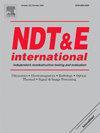Few-shot ultrasonic defect classification in insulation materials using finite element simulation and Siamese neural networks
IF 4.1
2区 材料科学
Q1 MATERIALS SCIENCE, CHARACTERIZATION & TESTING
引用次数: 0
Abstract
High-performing models for structural defect classification and intelligent recognition generally require extensive, high-quality datasets. However, acquiring authentic defect data is usually costly. This paper investigates an intelligent defect classification model based on a Siamese neural network, utilizing extensive finite element simulation data supplemented by a limited set of experimental data. This study focuses on basin-type insulator materials with internal circular hole defects. For each of the 11 different defect sizes and locations, 300 simulation samples were generated and embedded with experimental noise. An ultrasound signal was measured for each defect type and paired with the corresponding simulation data to form the training set. A Siamese neural network was constructed to extract common features from both the experimental and simulation datasets. The model was tested using experimental data from various defect specimens, resulting in a classification accuracy exceeding 95 % on the two-dimensional reconstructed experimental data. The research showed that the accuracy of the model with a single input experimental sample is comparable to the supervised learning results with 80-shot setting. This indicates that the Siamese neural network can effectively learn common features between simulated and experimental data, achieving satisfactory classification performance even with a small number of experimental samples.
基于有限元模拟和Siamese神经网络的绝缘材料少射次超声缺陷分类
用于结构缺陷分类和智能识别的高性能模型通常需要大量高质量的数据集。然而,获取真实的缺陷数据通常是昂贵的。本文利用大量的有限元仿真数据和有限的实验数据,研究了一种基于Siamese神经网络的智能缺陷分类模型。本文主要研究了内部有圆孔缺陷的盆型绝缘子材料。针对11种不同的缺陷尺寸和位置,生成300个模拟样本并嵌入实验噪声。对每种缺陷类型测量一个超声信号,并与相应的仿真数据配对形成训练集。构建了Siamese神经网络,从实验数据集和仿真数据集中提取共同特征。利用各种缺陷试件的实验数据对模型进行测试,对二维重构实验数据的分类准确率超过95%。研究表明,单输入实验样本模型的准确率与80次设置的监督学习结果相当。这表明Siamese神经网络可以有效地学习模拟数据和实验数据之间的共同特征,即使在少量实验样本下也能取得令人满意的分类性能。
本文章由计算机程序翻译,如有差异,请以英文原文为准。
求助全文
约1分钟内获得全文
求助全文
来源期刊

Ndt & E International
工程技术-材料科学:表征与测试
CiteScore
7.20
自引率
9.50%
发文量
121
审稿时长
55 days
期刊介绍:
NDT&E international publishes peer-reviewed results of original research and development in all categories of the fields of nondestructive testing and evaluation including ultrasonics, electromagnetics, radiography, optical and thermal methods. In addition to traditional NDE topics, the emerging technology area of inspection of civil structures and materials is also emphasized. The journal publishes original papers on research and development of new inspection techniques and methods, as well as on novel and innovative applications of established methods. Papers on NDE sensors and their applications both for inspection and process control, as well as papers describing novel NDE systems for structural health monitoring and their performance in industrial settings are also considered. Other regular features include international news, new equipment and a calendar of forthcoming worldwide meetings. This journal is listed in Current Contents.
 求助内容:
求助内容: 应助结果提醒方式:
应助结果提醒方式:


